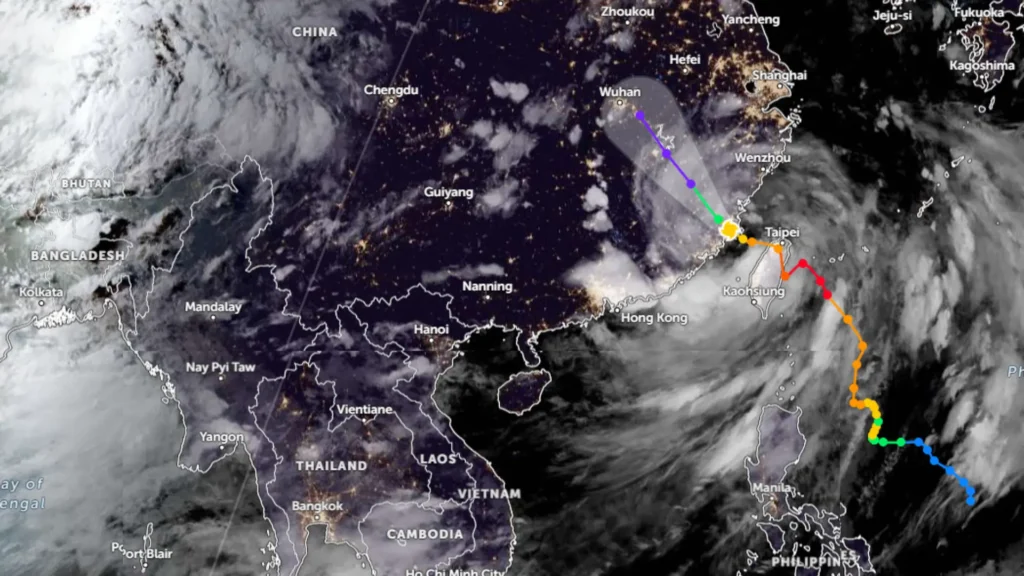Typhoon Gaemi Hits Taiwan and Philippines
Typhoon Gaemi has wreaked havoc in Taiwan and the Philippines, causing widespread damage, casualties, and disruptions. This powerful storm has led to significant search and rescue operations, highlighting the vulnerabilities and preparedness of these regions. In this article, we’ll delve into the impacts of Typhoon Gaemi, examining the immediate effects and the ongoing efforts to mitigate the damage.
Impact on Taiwan
The Taiwan coast guard is currently searching for a cargo ship with nine crew members that has sunk off its southern coast. The Tanzania-flagged freighter was off the southern port city of Kaohsiung when Taiwan was struck by Typhoon Gaemi. This incident has raised concerns about maritime safety during extreme weather conditions.
Details on the Tanzania-Flagged Freighter
The freighter, carrying essential goods, faced the full brunt of Typhoon Gaemi. The storm’s intensity overwhelmed the vessel, leading to its unfortunate sinking. Efforts to locate the missing crew members are ongoing, with rescue teams working tirelessly despite challenging weather conditions.
Impact on the Philippines
In the Philippines, the storm’s relentless rain has caused a tanker carrying nearly 1.5 million liters of industrial fuel to capsize. This incident has sparked fears of environmental contamination and prompted urgent rescue operations.
Rescue Operations for MT Terra Nova Crew
Sixteen crew members of the Philippine-flagged MT Terra Nova have been rescued, while one remains missing. The capsized tanker has posed significant challenges for rescue teams, who are battling adverse weather conditions to locate the missing individual and secure the vessel.
Casualties and Injuries
Typhoon Gaemi made landfall on Taiwan’s east coast on Wednesday, resulting in the deaths of three people and injuring hundreds more. The storm exacerbated rainy conditions in the Philippines, where eight people have died. These numbers are expected to rise as rescue operations continue and more information becomes available.
Rescue and Recovery Efforts
Search Operations in Taiwan
In Taiwan, search and rescue teams are scouring the coastal areas and the ocean for the missing crew of the cargo ship. Advanced technology and international assistance have been deployed to enhance the effectiveness of these operations.
Rescue Operations in the Philippines
In the Philippines, the coast guard and local authorities are working round the clock to rescue and provide aid to those affected by the storm. The capsized MT Terra Nova has become a focal point, with efforts to prevent an ecological disaster while ensuring the safety of the crew.
Weather Conditions and Challenges
Typhoon Gaemi has brought relentless rain and strong winds, complicating rescue missions and recovery efforts. The heavy rainfall has led to flooding and landslides, further endangering the lives of residents and rescue workers alike.
Government and Military Response
In response to the storm, Taiwan has canceled parts of its largest annual military drills, almost all domestic flights, and more than 200 international flights. The government is prioritizing public safety and resource allocation to manage the crisis effectively.
Local Authorities’ Actions
Local authorities across Taiwan and the Philippines have enacted evacuation measures and issued public safety advisories. More than 8,000 people across the island have been temporarily relocated by local authorities, ensuring their safety amidst the storm’s fury.
Environmental Impact
The capsized tanker in the Philippines has raised significant environmental concerns. The potential fuel spill poses a threat to marine life and coastal ecosystems. Authorities are taking precautionary measures to contain any possible spills and mitigate environmental damage.
Fuel Spill Risks in the Philippines
Efforts are underway to secure the capsized tanker and prevent fuel leakage. Environmental agencies are on high alert, prepared to respond swiftly to any signs of contamination.
Personal Stories and Experiences
Survivors and local communities have shared harrowing accounts of their experiences during Typhoon Gaemi. These personal stories highlight the human aspect of the disaster, bringing attention to the resilience and solidarity of the affected communities.
Comparison to Previous Typhoons
Historically, Typhoon Gaemi‘s impact is being compared to past typhoons in the region. While every storm brings its unique challenges, the severity and response strategies provide valuable insights for future preparedness.

Media Coverage and Public Awareness
The media has been instrumental in reporting the events surrounding Typhoon Gaemi. Public awareness campaigns and social media have played crucial roles in disseminating information, ensuring that people stay informed and take necessary precautions.
Long-term Consequences
The economic impact of Typhoon Gaemi on Taiwan and the Philippines is expected to be substantial. From infrastructure damage to disrupted trade, the long-term consequences will require coordinated recovery plans and international support.
Economic Impact on Taiwan and the Philippines
Both countries are assessing the financial toll of the disaster. Recovery efforts will focus on rebuilding infrastructure, supporting affected communities, and restoring normalcy.
Preventative Measures for Future Typhoons
To mitigate the effects of future typhoons, governments are developing more robust strategies and enhancing community preparedness. These measures include improved early warning systems, better infrastructure planning, and public education campaigns.
Typhoon Gaemi has left a lasting impact on Taiwan and the Philippines, challenging both nations with its destructive force. The ongoing rescue and recovery efforts underscore the resilience and determination of the affected communities. As these regions rebuild, the lessons learned from this disaster will be crucial in enhancing preparedness and response for future typhoons.
